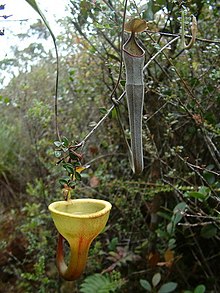Simpatri
Dalam ilmu biologi, simpatri adalah suatu keadaan ketika dua spesies atau populasi hidup di wilayah geografis yang sama sehingga sering kali saling bertemu.[1] Populasi yang pada awalnya saling berkawin dan kemudian terbagi menjadi dua spesies atau lebih merupakan contoh spesiasi simpatrik. Spesiasi semacam ini disebabkan oleh isolasi reproduktif - yang membuat keturunan campuran tak dapat bereproduksi, sehingga mengurangi aliran gen - yang mengakibatkan perbedaan genetik.[2] Spesiasi ini berlawanan dengan spesiasi alopatrik di mana spesies terbentuk akibat isolasi geografis.


Catatan kaki
sunting- ^ Futuyma 2009, hlm. 448, G-9.
- ^ Futuyma 2009, hlm. 241.
Daftar pustaka
sunting- Bot, A.N.M.; Rehner, S.A. & Boomsma, J.J. (October 2001). "Partial Incompatibility between Ants and Symbiotic Fungi in Two Sympatric Species of Acromyrmex Leaf-Cutting Ants". Evolution. 55: 1980–1991. doi:10.1111/j.0014-3820.2001.tb01315.x. JSTOR 2680446.
- Coyne, Jerry A. & Orr, H. Allen (March 1989). "Patterns of Speciation in Drosophila". Evolution. hlm. 362–381. JSTOR 2409213.
- Dieckmann, U. & Doebeli, M. (July 1999). "On the origin of species by sympatric speciation" (PDF). Nature. 400: 354–357. doi:10.1038/22521.
- Foote, A.D.; Morin, P.A.; Durban, J.W.; et al. (September 2011). "Out of the pacific and back again: insights into the matrilineal history of pacific killer whale ecotypes". PLOS ONE. 6 (9): e24980. doi:10.1371/journal.pone.0024980.
- Futuyma, D.J. (2009). Evolution (edisi ke-2nd). Sunderland, Massachusetts: Sinauer Associates. ISBN 978-0-87893-223-8.
- McCoy, K.D. (September 2003). "Sympatric speciation in parasites – what is sympatry?" (PDF). Trends in Parasitology. 19 (9): 400–404. doi:10.1016/S1471-4922(03)00194-6.[pranala nonaktif permanen]
- Noor, M.A.F. (November 1999). "Reinforcement and other consequences of sympatry" (PDF). Heredity. 83 (5): 503–508. doi:10.1046/j.1365-2540.1999.00632.x.
- Roberts, A.; Tarboton, W. (2011). Roberts' Guide to the Nests and Eggs of Southern African Birds. John Voelcker Bird Book Fund. ISBN 978-0-620-50629-8.
- Soler, M. & Moller, A.P. (February 1990). "Duration of sympatry and coevolution between the great spotted cuckoo and its magpie host" (PDF). Nature. 343: 748–750. doi:10.1038/343748a0.